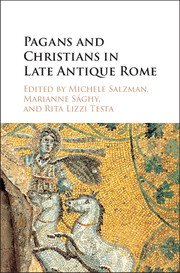 Pagans and Christians in Late Antique Rome
Pagans and Christians in Late Antique Rome Book contents
- Frontmatter
- Contents
- List of Illustrations
- Biographies of Authors
- Acknowledgments
- Introduction
- Part I SENATORIAL POLITICS AND RELIGIOUS CONFLICT
- Part II The Construction of New Religious Identities
- Part III Pagans and Christians: Coexistence and Competition
- Section A Pagans and Religious Practices in Christian Rome
- Section B Death and the Afterlife
- 12 Reinterpreting “Pagans” and “Christians” from Rome's Late Antique Mortuary Evidence
- 13 On the Form and Function of Constantine's Circiform Funerary Basilicas in Rome
- 14 Romanae gloria plebis: Bishop Damasus and the Traditions of Rome
- 15 Storytelling and Cultural Memory in the Making: Celebrating Pagan and Christian Founders of Rome
- Section C Reading Religious Iconography as Evidence for Pagan–Christian Relations
- Concluding Remarks: Vrbs Roma between Pagans and Christians
- Index
- References
12 - Reinterpreting “Pagans” and “Christians” from Rome's Late Antique Mortuary Evidence
from Section B - Death and the Afterlife
Published online by Cambridge University Press: 05 November 2015
- Frontmatter
- Contents
- List of Illustrations
- Biographies of Authors
- Acknowledgments
- Introduction
- Part I SENATORIAL POLITICS AND RELIGIOUS CONFLICT
- Part II The Construction of New Religious Identities
- Part III Pagans and Christians: Coexistence and Competition
- Section A Pagans and Religious Practices in Christian Rome
- Section B Death and the Afterlife
- 12 Reinterpreting “Pagans” and “Christians” from Rome's Late Antique Mortuary Evidence
- 13 On the Form and Function of Constantine's Circiform Funerary Basilicas in Rome
- 14 Romanae gloria plebis: Bishop Damasus and the Traditions of Rome
- 15 Storytelling and Cultural Memory in the Making: Celebrating Pagan and Christian Founders of Rome
- Section C Reading Religious Iconography as Evidence for Pagan–Christian Relations
- Concluding Remarks: Vrbs Roma between Pagans and Christians
- Index
- References
Summary
The great Christian catacombs of Rome – Commodilla, Priscilla, Domitilla, Sebastian, Callixtus, to name only the largest complexes – have been since the Renaissance the chief data set for discovering the nature of emergent Christianity “on the ground,” or better, underground. Here, frescoed on the walls of plastered tufa and traced along the ancient routes of the pious, one can witness the rise of a new yet robust Christian identity, already coalesced in the third century. The catacombs reveal a large and protected ancient community of ordinary humble citizens of Rome, united in their vision of an eternal refrigerium that awaited them. Unlike their pagan adversaries, Christians created vast networks of subterranean eschatological hope, clustered together against the pressures of superstition and the sham religions of pagan imitators, against those who believed that death was the end and who abandoned their dead in the cold, dark ground.
Given the potential usefulness of the catacombs as a data set for recovering emergent Christianity, it seems important to consider them as we determine to what degree the terms pagan and Christian are useful or accurate to describe religious identities in late antique Rome. Surely Christians distinguished themselves from pagans in their chosen mode of burial, such that we might be able to discern difference, if not actual conflict, from their archaeological remains. Indeed, the very phenomenon of “Christian catacombs” presupposes difference – a distinct Christian community, united in doctrine and praxis, living in the broader environment of the late Roman city. There are no “pagan catacombs,” only the scant remains of pagan hypogea and necropoleis. Yet this supposition – that Christian catacombs reflect the sturdiness, differentiation, and united front of emergent Christianity against paganism – while not incorrect, is fraught with interpretive pitfalls. The picture painted in the opening paragraph of this chapter – often found with only slight variations in scholarship – is entirely wrong. It has emerged, not from the astonishing 170 kilometers of catacombs that are indeed critical sources for uncovering late antique Christianity, but from a way of reading them that has remained dominant and authoritative until very recently.
The centrality of the Roman catacombs to Catholic self-identity began with their “rediscovery” fortuitously one day in 1578, when workers laboring at the Vigna Sanchez off the Via Salaria punctured the soft tuff to discover a vast labyrinth of graves below.
- Type
- Chapter
- Information
- Pagans and Christians in Late Antique RomeConflict, Competition, and Coexistence in the Fourth Century, pp. 273 - 290Publisher: Cambridge University PressPrint publication year: 2015


